
TED'S
ASTROPIX:
Astronomical
imaging in, around, under and through the Columbus nebula, located
deep in the Central Ohio Cloud Zone (COCZ).
© 2008-2013 Ted Saker, Jr. All rights
reserved.
Country
of First Publication: The United States of America
These works are for the
personal viewing and enjoyment of visitors to this site.
Any and all commercial use
of these images is absolutely, strictly and totally prohibited
without my consent.
Remember,
I sue people professionally. Besides Astronomy, it's what I live for.
Page Created: 23 June 2008.
New postings to this page appear in colored type.
Below is my gallery of images taken in various locations in and around the Columbus nebula. Unless otherwise indicated, images were taken with the following equipment:
Imaging sensor: Santa Barbara Instruments Group ST-8XME (NABG) CCD camera, SBIG color filter wheel model CFW10SA with Custom Scientific LRGBHa, Schuler SII and Baader OIII filters, and SBIG adaptive optics unit model AO-8.
Optics: Celestron C-11 Schmidt-Cassegrain Telescope (with Celestron focal reducer @ f/6.3).
Mount: Losmandy G-11 GEM equipped with the Gemini GOTO system.
Software: MaxIm DL v. 4 (2010) v. 5 (2011).
Images found in the Comparison Gallery: The Clash of the Has-Been Cameras. (2006-2010)
IMAGER'S LOGS
Imager's Log, 29 October 2013: It's been some time since I updated this page twice in one month, but things have been happening in the COCZ. I took on another ATM project. The goal was to repair a damaged Astro Tech AT8RCF, a very nice astrograph. Through the auspices of the good folks at Astronomics, I completed the rehabilitation of the instrument within a week. The old astronomer's superstition about a new telescope guaranteeing bad weather did not hold up, and clear skies enabled me to capture a narrowband color image of the Crescent Nebula (NGC 6888). Taking color layers of this object has long eluded me. Bonus image is a pic of the Triple Conjunction of Mercury, Venus and Jupiter. These three bright planets formed a neat equilateral triangle low in the sky at dusk on May 26, 2013. I took this pic with a point and shoot camera as I was perched precariously on the edge of the roof of my house. |
Imager's Log, 15 October 2013: I've been busy, which may explain why I haven't updated this page for almost 18 months. Since the last update, I posted the Cherry Springs Star Party 2012 page, the Transit of Venus page, the Black Forest Star Party 2012 page, and the Winter Star Party 2013 page. More pages remain to be written, but I've done some new work with narrowband filters from my site deep in the Bortle 9 COCZ. There's a significant difference between the processing techniques for narrowband images and those used for RGB images. This is, I believe, the first time I have enough subs to try new processing techniques. At this time of year, there are only two objects I can image, given the lousy sight lines: The Ring Nebula (M57) and the Dumbbell Nebula (M27). I've devoted many hours to these objects over the years. Compare the narrowband images to the standard LRGB images and see the differences between the color renderings. |
Imager's Log, 20 May 2012: TSP may have come and gone, but it's still galaxy season. Good weather settled into the COCZ this week for a change. Also, as luck would have it, the moon is close to new with an annular eclipse coming up on the 20th. Taking advantage of nearly ideal conditions in the COCZ, I got outside with the AT6RC and added color layers to an image of M101 I took at TSP and bagged a couple more galaxies: M108 and Arp 29. All of them can be found in Ursa Major which happens to be ideally placed at this time of the year. I'm still trying to get the feel of integration lengths for deep sky objects with this scope and camera. The Transit of Venus is coming up in another two and a half weeks, and I am getting solar imaging equipment ready for that event. The astrograph mirror underwent some regrinding last week and now I'm polishing again. I'll see what, if anything, comes of all this toil and travail. In the meantime, imaging and processing continues. |
Imager's Log, 30 April 2012: The 2012 Texas Star Party has come and gone. I processed and posted the images I took. I wrote a blog about the great times at TSP. Back in the COCZ, reality set back in. Clouds. Light polluted skies. Full moon week. No images to process. No imaging at all. Until I find something else to do, like resuming the seemingly impossible, endless polishing of a 6" f/4.5 mirror I started making six months ago, I thought I'd post one of the final images from 2011. It's not particularly good, but it is noteworthy for being the first color image taken with my narrowband filters. |
Imager's Log, 08 August 2011: There's one annoying problem about this part of summer under the Columbus Nebula: my obstructed horizon. All the really good summertime objects are located in southerly constellations well buried in the trees. There are very few objects I can image. According to the charting software, the only objects I could get at in the time I had were tiny planetary nebulas, a few globulars and some open clusters. However, an old, dear acquaintance. The Ring Nebula, was ideally placed for an imaging run. The Ring is one of the first deep sky objects I ever observed as it is easily located and observed. Three years have passed since I last imaged The Ring (see the Comparison Page for prior efforts) and I was very pleased by the outcome of this effort. Since we're heading into full moon time, I suspect that the next time I'll get to image is at the Black Forest Star Party, coming up at the end of the month. |
Imager's Log, 09 June 2011: Trying to make up for an unusually long cloud season, including record precipitation in April, conditions in the Columbus Nebula and COCZ were pretty decent this week, allowing me the opportunity to bag another tricolor image-M64-and another image of the supernova in M51. It was very satisfying being able to sit outside in the wee hours of the morning without the need for multiple layers of clothing. |
Imager's Log, 04 June 2011: Got the chance this week to get outside and image a new target, M106. The next day, I read that a supernova has been discovered in M51. I processed the M106, but also decided to get a new image of M51 to compare with last year's images. I created an animated pic confirming the supernova's existence. |
Imager's Log, 16 May 2011: This cloud season's contract has apparently been given a lengthy extension., eating deeply into galaxy season. I'm getting pretty impatient for some decent skies. However, since this is full moon week, I will have to be patient for a bit. To pass the time waiting for better conditions, I played around with the M101 I shot nearly a year ago. Hard to believe it's been that long. I also posted it on the Reprocessing Page. I did not have any flat frames which made processing and reprocessing it a steep challenge. |
Imager's Log, 01 May 2011: It's official. The COCZ broke a 118 year old record for April rainfall. What this means is I could only get the scope out two nights (or parts thereof) and I tried to make the most of it by going after a couple of objects I had not tried before. One is a rather oddly named globular cluster known as the Intergalactic Wanderer, so named because when it was discovered, it was thought not to be in orbit around the Milky Way Galaxy, but an interloper from beyond. The second is a well known spiral galaxy in Ursa Major called Bode's Nebula, but more widely known as M81. The last time I imaged this galaxy was with the Cookbook camera at Okie-Tex 2001. It's hard to believe it took me ten years to target this galaxy again, and the state of the art has made all the difference. |
Imager's Log, 25 March 2011: Having built up a sizable inventory of images I've reprocessed, I set up a new page to show the evolution of image processing strategies I've picked up in the past six months. |
Imager's Log, 23 March 2011: I just can't seem to leave the M51 raw frames well enough alone. As I practice my processing skills with the aid of Warren Keller's IP4AP, I attempted to create a better image applying the lessons in the tutorials. Since cloud season in the Columbus nebula shows no sign of ending anytime soon, I have to work with the original raw frames. Reprocessing also shows me whether or not I'm improving. I think the third effort extracted more detail, shows better color balance and has improved contrast as compared to the first and second efforts. I'm getting anxious to get out and get new data. |
Imager's Log, 15 March 2011: After processing the very few images WSP 2011 conditions permitted, I discovered a set of images of M 13 aka the Great Northern Globular I took last summer that somehow escaped processing until recently. Beware the Ides of March! |
Imager's Log, 23 February 2011: I finally got around to processing and posting yet another image of M 27 (The Dumbbell Nebula), a favorite late summer object owing to its favorable position. I'm not very satisfied with this image. I took it around August 9, 2010, about the same time as the H-a Crescent image, during summertime nebula season. Light and air pollution made the color balancing a serious challenge. |
Imager's Log, 17 February 2011: Here in the COCZ, a nice February thaw briefly drove away the winter doldrums with a promise of spring to come soon. It's full moon time, so taking new pics is not practical even if sky conditions permitted. The next best thing to taking new images is reprocessing old ones. This time, I took a crack at the M 51 image I posted on July 24, 2010. The problem with these frames is the vignetting (caused by the combination of focal reducer, light pollution, atmospheric conditions, lack of flat framing and integration lengths) which made the original and reprocessing efforts difficult, especially when it came to color balancing and background. I think the second effort paid off, as I believe I teased more detail from the arms and the bridge. I'm learning more and more about how to process less than perfect raw frames. |
Imager's Log, 13 February 2011: How, you may ask, do astro-imagers pass the time during cloud season? We practice image processing skills on images we previously took. This cloud season has been above average in viciousness, and curling up in front of a warm computer helped keep imaging fever stoked. The first image I reworked was the M 63 I posted on July 24, 2010. I was amazed at the amount of detail in the image that my prior effort failed to enhance. |
Imager's Log, 16 November 2010: One last breath of summer cleared the skies for a few nights last week with moderate temperatures. Combined with a waxing crescent moon that set reasonably early, conditions were right for some more imaging. Despite many hours of acquiring color layers of the Crescent Nebula over the past two months, I kept missing the mark for one reason or another. Usually it was because of my failure to align the object on the chip properly. This week I finally aligned the object properly and got color layers. I invite comparison with the H-alpha image I captured over the summer. I also did a tricolor imaging run on M 74, a spiral galaxy in Pisces. It's posted on the bottom row, left frame. |
Imager's Log, 03 November 2010: Last chance imaging before cloud season sets in. One fall galaxy I wanted to bag is a small but bright irregular (peculiar?) spiral galaxy in Cepheus (or Cygnus, depending on which catalog and/or program is referenced). With the acquisition of the new imaging train, the rest of the ST-8E images have been relocated to the Comparison Gallery. |
Imager's Log, 11 October 2010: The Black Forest Star Party yielded such good results, I couldn't help but attend another star party. This time, I went to my first Hidden Hollow Star Party. Held on the grounds of the Warren Rupp Observatory October 7-10, and only 67 miles from home, it is certainly the closest one to the Columbus Nebula. Central Ohio was blessed with ideal weather but I could only go for two days. Nevertheless, we attendees experienced two very clear nights (with the exception of some patchy clouds that occasionally drifted in and out). Apart from some pesky equipment problems, a good time was had by all. I might have been more productive if I hadn't had to chase a gremlin down. |
Imager's Log, 14 September 2010: As Summer Nebula Season comes to a close, the last star party of the summer beckoned. While under the Columbus nebula, I began imaging the Splinter Galaxy while waiting for the Crescent Nebula to cross the meridian. The luminance frames were terrible, but combining the color frames with new luminance frames taken at the Black Forest Star Party, held at the Cherry Springs (PA) State Park from September 9 through 11, 2010, yielded a decent image. I also seized the opportunity to bag an image of an object that had eluded me over the years—the Eagle Nebula, aka M 16. I had tried to get the Eagle at past Texas Star Parties but never achieved a satisfactory image. It's really amazing how much a dark sky makes a difference in image acquisition and processing. Technically, the Eagle, Veil and M 33 images weren't taken under the Columbus nebula but “around” it—about 400 miles away—and when the M 101 image is compared to the Splinter Galaxy image, the advantage of a the BFSP's dark sky is readily apparent. The drive was well worth it, even for the one night of imaging conditions experienced at the site. It was a great event. |
Imager's Log, 14 August 2010: Summer Nebula Season begins. |
Imager's Log, 24 July 2010: New images! New gear! Spring Galaxy Safari: M 51, M 63 and M 101. |
Imager's Log, 8 September 2008: New! NGC 6543 Planetary Nebula “The Cat's Eye” in Draco. (Moved to the Comparison Gallery 4 Nov. 10) |
Imager's Log, 24 August 2008: The Comparison Gallery has its own page! Clash of the Has-been Cameras: The ST-8 (KAF-1600) ABG v. ST-8E (KAF-1602E) NABG. Which one is the superior? Most of the blue bordered pictures will be found here. Images with red borders were taken with the SBIG ST-8 (ABG) camera with AO-7, SBIG CFW-10 with Custom Scientific LRGBHa filters (for tricolor images), Celestron C-11 Schmidt-Cassegrain optical system, and Losmandy Gemini G-11 GEM. Images processed with MaxIm DL™ v. 4.53 (2006-2008). Images with blue borders were taken with the SBIG ST-8E (NABG) camera with the same accessories (2008-2010). |
Imager's Log, 30 July 2008: An unusual convergence of weather, moon phase and scheduling enabled me to conduct two imaging runs on two successive nights. At this time of year, there are very few objects I can image well due to my obstructed horizon. The effect of these conditions allows me to concentrate on a small number of objects. I acquired quite a bit of data to process. The first object tricolor done and processed is the Great Globular Cluster in Hercules. The Comparison Gallery shows the difference between the ABG (Kodak KAF-1600) and NABG (Kodak KAF-1602E) chip, as well as the performance increase of the 8E's chip over the 8. |
Imager's Log, 25 July 2008: Through a number of fortunate events, I was able to acquire a vintage SBIG ST-8E NABG camera earlier this month by parting with my venerable ST-8 ABG unit. Weather and schedule considerations allowed me several nights since the acquisition to put it through its paces. I am very happy with this camera's performance. The M27 image posted this date shows the sensitivity difference between the NABG chip in the 8E and the ABG chip in the 8. Plus, my guiding has improved immensely. I am very encouraged by these early efforts. NB: All ST-8 and ST-8E images have been relocated to the Comparison Gallery. |
CCD IMAGES
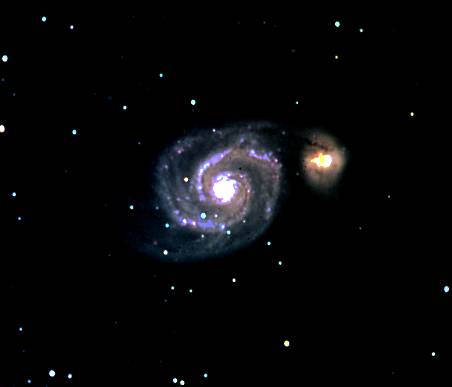 |
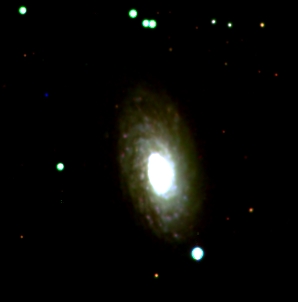 |
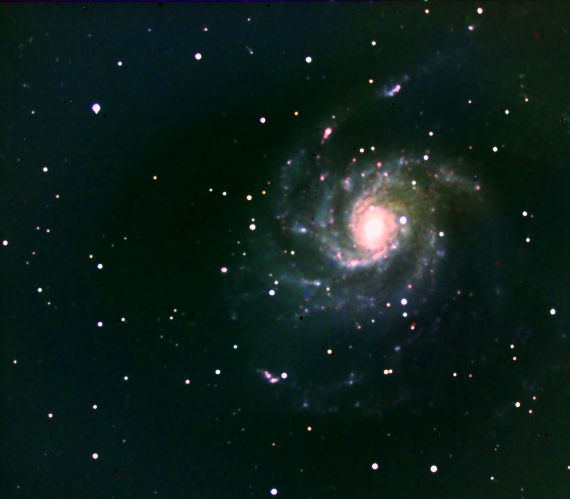 |
M 51 Spiral Galaxy “The Whirlpool” in Canes Venatici. 60 min. L, 30 min. R, 30 min. G, 60 min. B, C-11 @ f/6.3. Taken 30 June & 1 July 2010, from under the Columbus nebula. Posted 24 July 2010 The holy grail of astrophotography Compare this to the reprocessed image below. Posted 17 Feb. 2011 |
M 63 Spiral Galaxy “The Sunflower” in Canes Venatici. 90 min. L, 25 min. R, 50 min. G, 170 min. B, C-11 @ f/6.3. Taken 16, 17, 29, and 30 June 2010, from under the Columbus nebula. Posted 24 July 2010 Compare this to the Posted 13 Feb. 2011 |
M 101 Spiral Galaxy in Ursa Major. 70 min. L, 75 min. R, 75 min. G, 130 min. B, C-11 @ f/6.3. Taken 3, 4, 11, 16 and 17 July 2010 from under the Columbus nebula. Posted 24 July 2010 Compare this to the reprocessed image below. Posted 16 May 2011 |
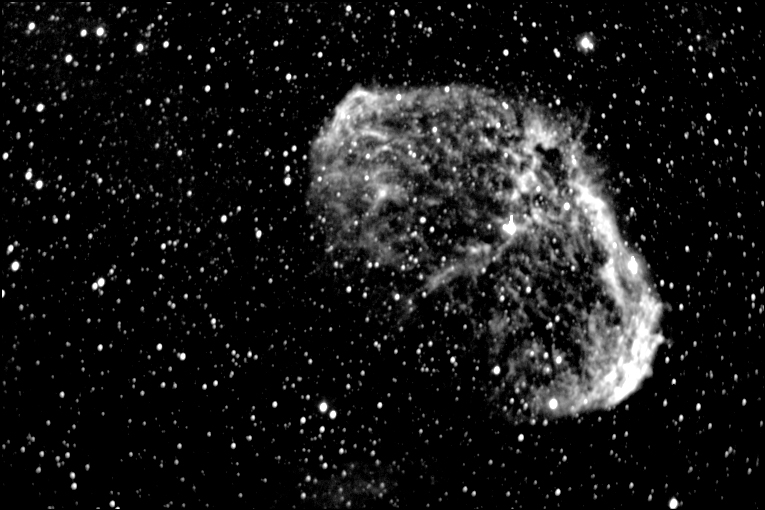 |
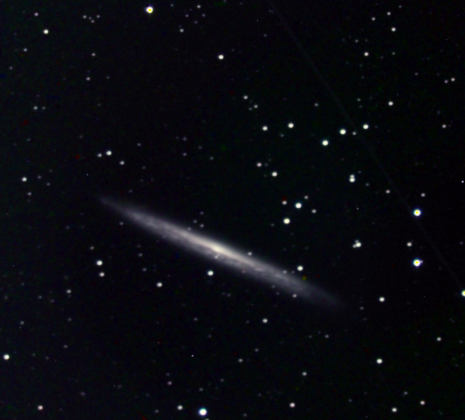 |
|
NGC 6888 Emission Nebula “The Crescent” in Cygnus. 60 min. H-alpha. C11 @ f/6.3 from under the Columbus nebula. Posted 13 Aug. 2010 Reprocessed with narrowband filter frames below. |
NGC 5907 Edge-on Galaxy “The Splinter” in Draco. 60 min L, 25 min. R, 25 min. G, 20 min. B (C11 @ f/6.3, RBG frames taken under the Columbus nebula 26 Aug. 10, L frames taken 9 Sep. 2010 at Posted 14 Sep. 2010 |
M 16 Cluster with Nebulosity “The Eagle” in Serpens Cauda. C11 @ f/6.3, 30 min. L, 15 min. R, 15 min. G, 15 min. B. Taken 9 Sep. 2010 at the Black Forest Star Party. See how far the art has progressed since the days of my Cookbook Camera. Posted 14 Sep. 2010 |
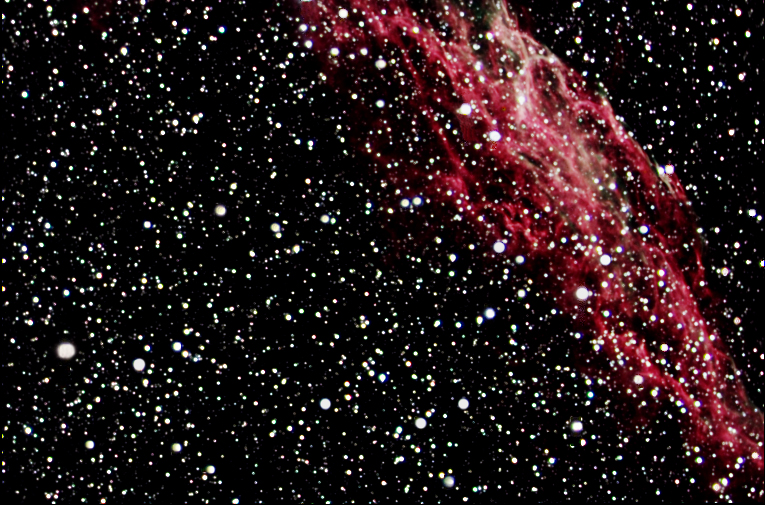 |
||
NGC 6992 Supernova Remnant “The Veil” in Cygnus. C11 @ f/6.3, 30 min. L, 15 min. R, 15 min. G, 30 min. B. Taken 9 Sep. 2010 at the Black Forest Star Party. Posted 14 Sep. 2010 |
M 33 Spiral Galaxy “The Pinwheel” in Triangulum. C11 @ f/6.3, 40 min. L, 20 min. R, 20 min. G, 10 min. B. Taken 9 Sep. 2010 at the how far the art has progressed in the ten years since my Cookbook Camera days. Posted 14 Sep. 2010 |
NGC 7635 Diffuse Nebula “The Bubble” in Cassiopeia. C11 @ f/6.3, 45 min. L, 30 min. R, 25 min. G, 30 min. B. Taken 9 Oct. 2010 at the Hidden Hollow Star Party, near Mansfield Ohio. Posted 11 Oct. 2010 |
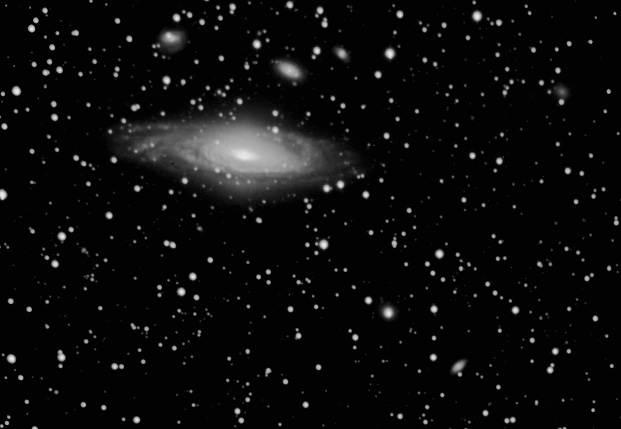 |
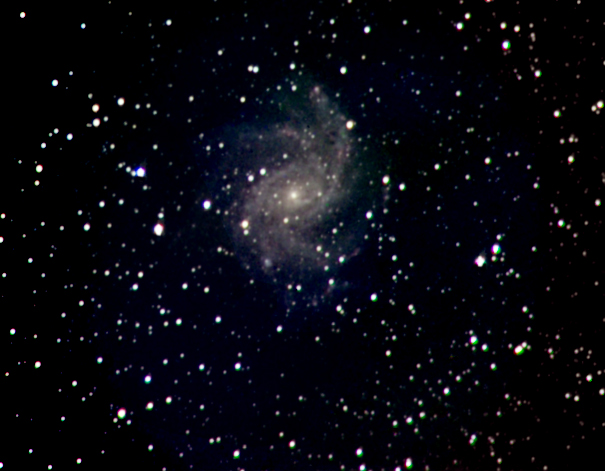 |
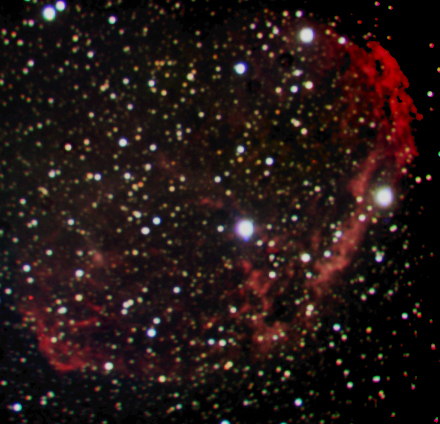 |
NGC 7331 Spiral Galaxy and companions “The Deer Lick Group” in Pegasus. C11 @ f/6.3, 30 min. L. Taken 9 Oct. 2010, at the Hidden Hollow Star Party, near Mansfield, Ohio. Posted 11 Oct. 2010 |
Arp 29 aka NGC 6946 Spiral Galaxy “The Fireworks” in Cepheus. LRGB 30 min. each layer. Taken 1 Nov. 2010, from under the Columbus nebula. Posted 3 Nov. 2010 |
NGC 6888 Emission Nebula “The Crescent” in Cygnus. 30 min. RGB each layer. C11 @ f/6.3 from under the Columbus nebula. Posted 16 Nov. 10 |
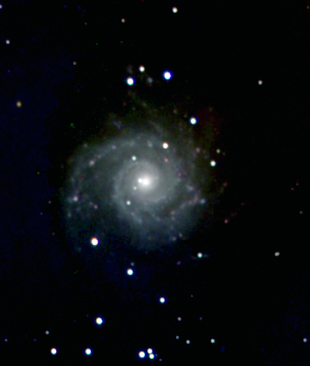 |
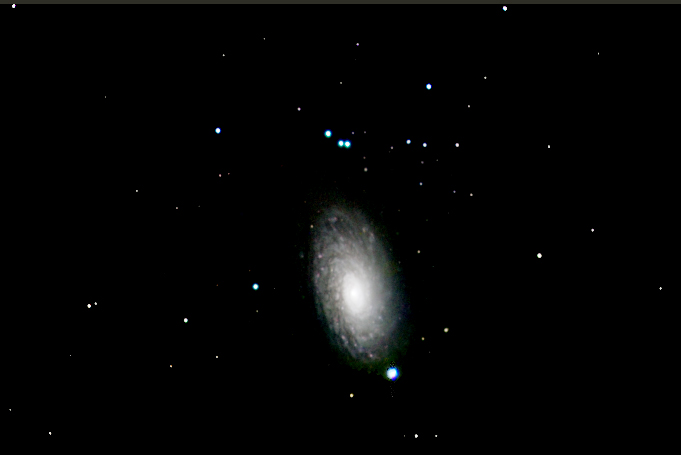 |
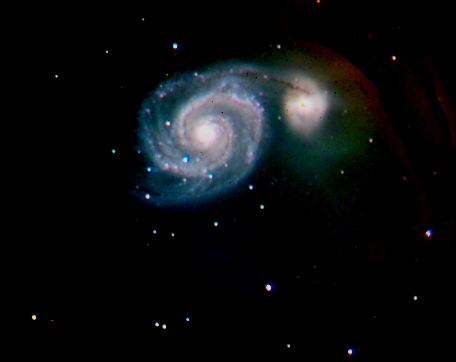 |
M 74 Spiral Galaxy in Pisces. 30 min. LRGB each layer. Taken 11 Nov. 10 from under the Columbus nebula. Posted 16 Nov. 2010 |
M 63 Spiral Galaxy “The Sunflower” in Canes Venatici. 90 min. L, 25 min. R, 50 min. G, 70 min. B, C-11 @ f/6.3. Originally taken 16, 17, 29, and 30 June 2010, from under the Columbus nebula, reprocessed and posted 13 Feb. 2011. Compare this image to the Posted 13 Feb. 2011 |
Arp 85 aka M 51 Spiral Galaxy “The Whirlpool” in Canes Venatici. 60 min. L, 30 min. R, 30 min. G, 60 min. B, C-11 @ f/6.3. Taken 30 June & 1 July 2010, from under the Columbus nebula, reprocessed and posted 15-17 Feb. 2011. Compare this image to the first processing effort. Posted 17 Feb. 2011 |
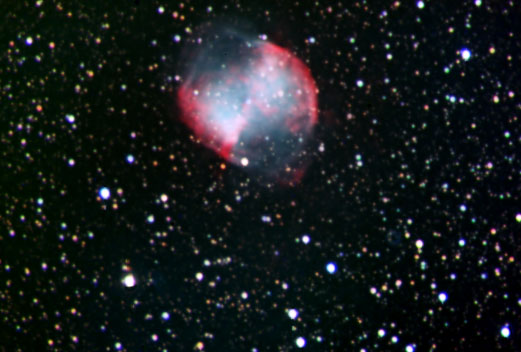 |
||
M27 Planetary Nebula “The Dumbbell” in Vulpecula. 60 min. L, 30 min. RGB. Originally taken c. Aug. 9, 2010, from under the Columbus nebula. Compare this image to the M 27 images in the Comparison Gallery and see how far the art has progressed since my Cookbook Camera days. Posted 23 Feb. 11 |
M 13 Globular Cluster "The Great Northern Globular" in Hercules. 10 min. L, 5 min. R, 7.5 min. G, 10 min. B. Taken August 8, 2010, from under the Columbus nebula. Compare this image to the M 13 images in the Posted 15 March 2011 |
M51 Spiral Galaxy “The Whirlpool” in Canes Venatici. 60 min. L, 30 min. R, 30 min. G, 60 min. B, C-11 @ f/6.3. Taken 30 June & 1 July 2010, from under the Columbus nebula, reprocessed 23 Mar. 2011. Compare this image to the first processing effort and the second effort just above. Posted 23 Mar. 2011 |
 |
||
NGC 2419 Globular Cluster “The Intergalactic Wanderer” in Lynx. 5 min. L, 4 min. R, 5 min. G, 6 min. B. Taken April 6, 2011, from under the Columbus nebula. Posted 1 May 2011 |
M 81 Spiral Galaxy “Bode's Nebula” in Ursa Major. 25 min. L, 30 min. R, 20 min. G, 25 min. B. Taken April 29, 2011, from under the Columbus nebula. Posted 1 May 2011 |
Arp 26 aka M 101 Spiral Galaxy in Ursa Major. 270 min. L, 75 min. R, 75 min. G, 130 min. B, C-11 @ f/6.3. Taken 3, 4, 11, 16 and 17 July 2010 from under the Columbus nebula. Compare this image to the first processing effort. Reprocessed, posted 16 May 2011 |
 |
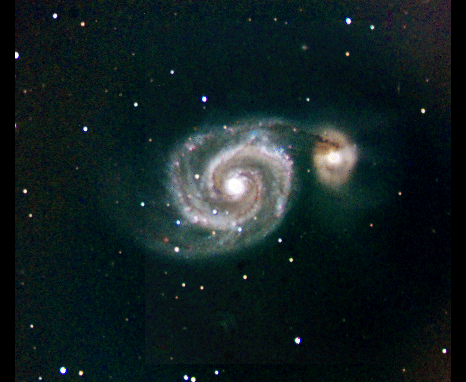 |
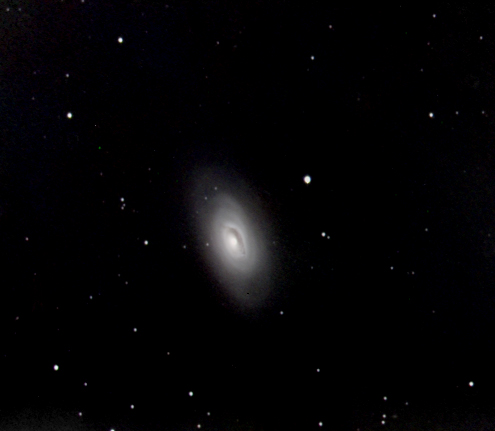 |
M 106 Spiral Galaxy in Canes Venatici. 60 min. L, 30 min. RGB. C-11 @ f/6.3. Taken 1 June 2011 from under the Columbus nebula. Posted 4 June 2011 |
Arp 85/M 51 Spiral Galaxy in Canes Venatici (“The Whirlpool”). This is an animation consisting of last year's tri-color combined with 60 min. luminance I took that evening after reading a June 3 report of the discovery of a supernova in this object. Can you see it? Posted 4 June 2011 If not, click on this link. Posted 9 June 2011 |
M 64 Spiral Galaxy in Canes Venatici (“The Black Eye”). 60 min. L, 30 min. RGB. C-11 @ f/6.3. Taken 6-7 June 2011 from under the Columbus nebula. Posted 9 June 2011 |
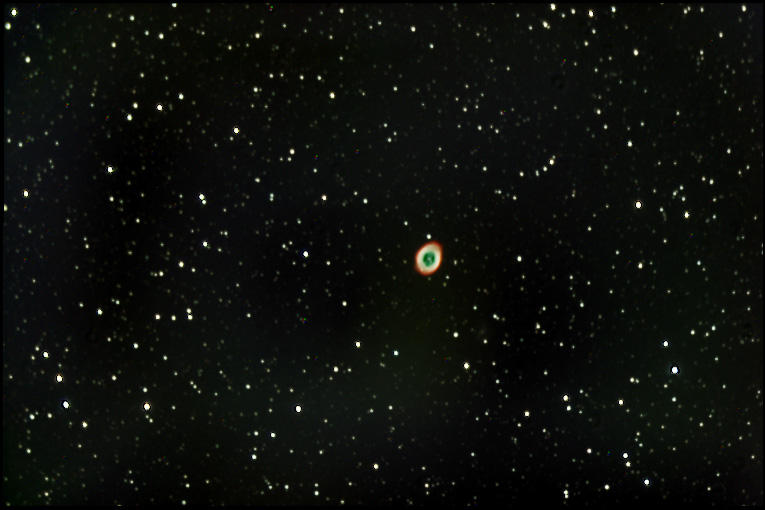 |
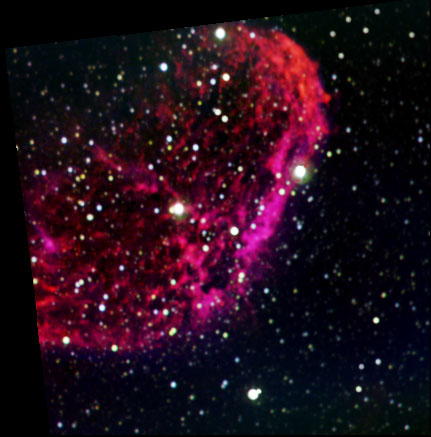 |
|
M 57 Planetary Nebula “The Ring” in Lyra. 60 min. L, 18 min. R, 18 min. G, 18 min. B, C-11 @ f 6.3. Taken 4 Aug. 2011, from under the Columbus nebula. View previous Ring images in the Comparison Gallery. Posted 8 Aug. 2011 |
The Crescent Nebula reprocessed as a tricolor image using the H-alpha image from above and adding S-II and O-III layers. My first attempt at narrowband imaging. C-11 @ f 6.3. Taken 7 Oct. 2011, from under the Columbus nebula. |
Arp 26 aka M 101 Spiral Galaxy in Ursa Major. 27.5 min. L, 27.5 min. R, 27.5 min. G, 27.5 min. B, AT6RC @ f/9. A hybrid image: L layer taken at the Texas Star Party, 16 Apr. 12, RGB layers 10 and 11 May 12 from under the Columbus nebula. Posted 20 May 2012 |
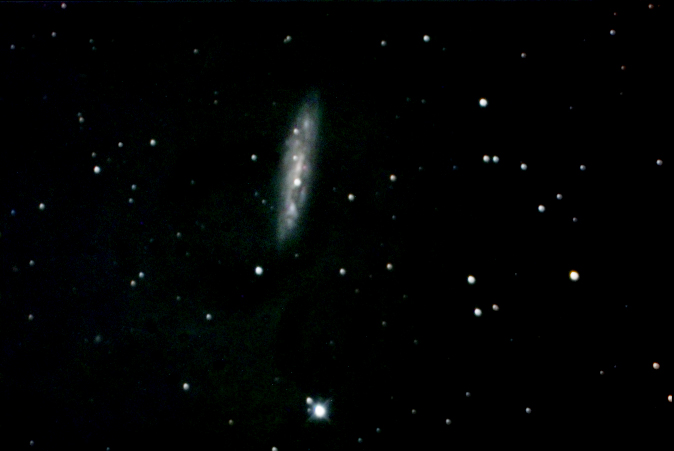 |
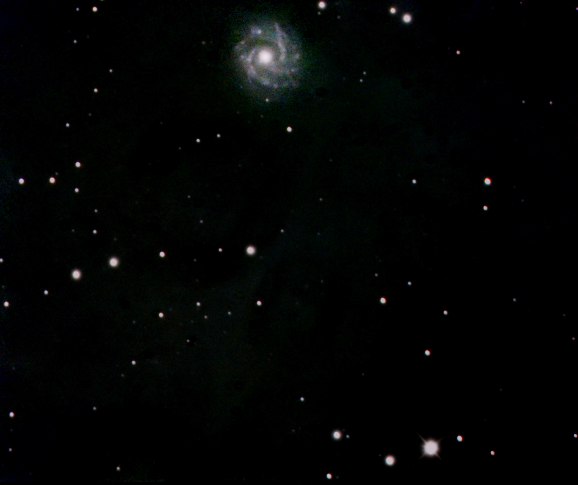 |
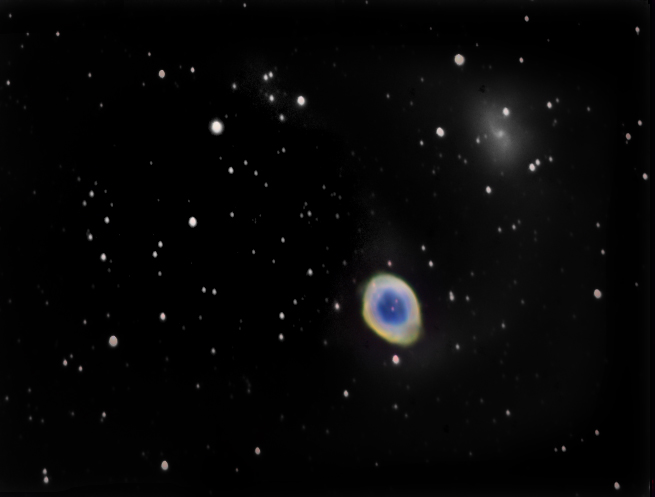 |
M 108 Spiral Galaxy in Ursa Major. 38.5 min. L, 33 min. R, 27.5 min. G, 33 min. B, AT6RC @ f/9. Taken 17 May 12 from under the Columbus nebula. Posted 20 May 2012 |
Arp 29 aka NGC 6946 Spiral Galaxy in Ursa Major. 38.5 min. L, 33 min. R, 27.5 min. G, 33 min. B, AT6RC @ f/9. Taken 18 May 12 from under the Columbus nebula. Posted 20 May 2012 |
M 57 Planetary Nebula “The Ring” in Lyra. C-11 @ f/10. 6000 secs. L, 4500 secs. H-a, S-II & O-III. Taken Jul. 25 & 30, 2013 from under the Columbus nebula. Combined using the Hubble Space Telescope palette. (The small galaxy in the frame is IC 1296 and I just missed capturing a supernova that was discovered in this galaxy about a week after I took the L subs. I couldn't tease anything out of the subs taken with the narrowband filters.) Posted 15 Oct. 2013 |
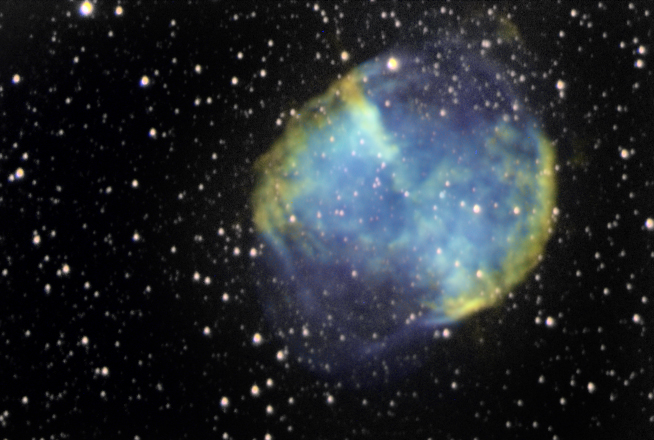 |
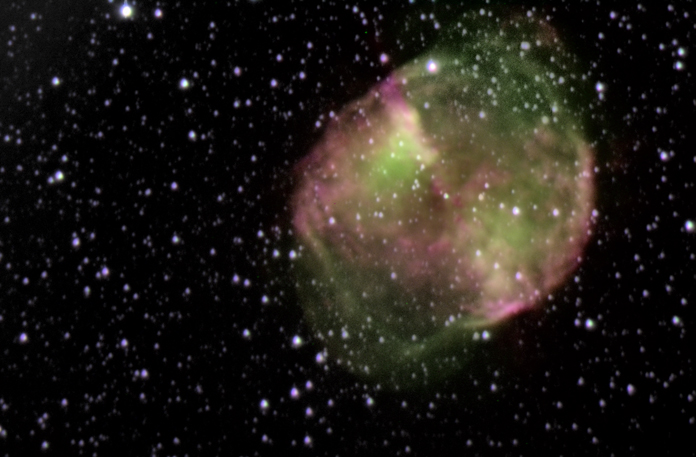 |
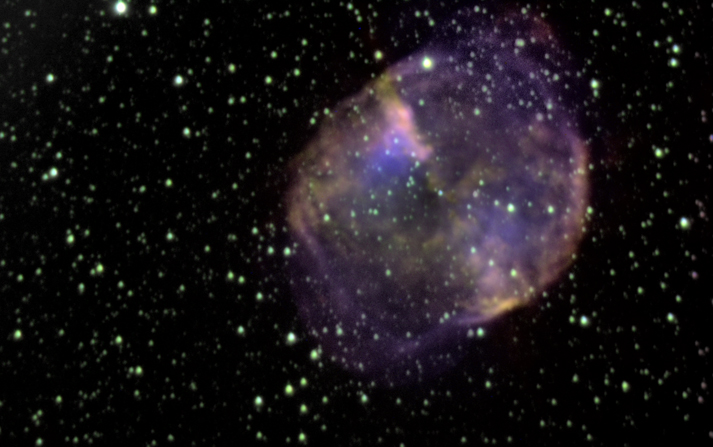 |
M 27 Planetary Nebula “The Dumbbell” in Vulpecula. C-11 @ f/10. 6000 secs. L, H-a, S-II & O-III. Taken Oct. 10-12, 2013 from under the Columbus nebula. Combined using the Hubble Space Telescope palette. Posted 15 Oct. 2013 |
M 27 Planetary Nebula “The Dumbbell” in Vulpecula. Same subs, combined using the Canada-France-Hawaii Telescope palette. Posted 15 Oct. 2013 |
M 27 Planetary Nebula “The Dumbbell” in Vulpecula. Same subs, combined using Kitt Peak palette. Posted 15 Oct. 2013 |
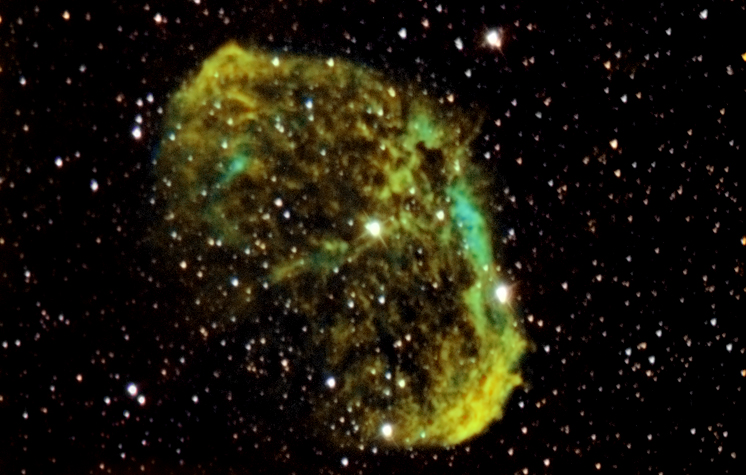 |
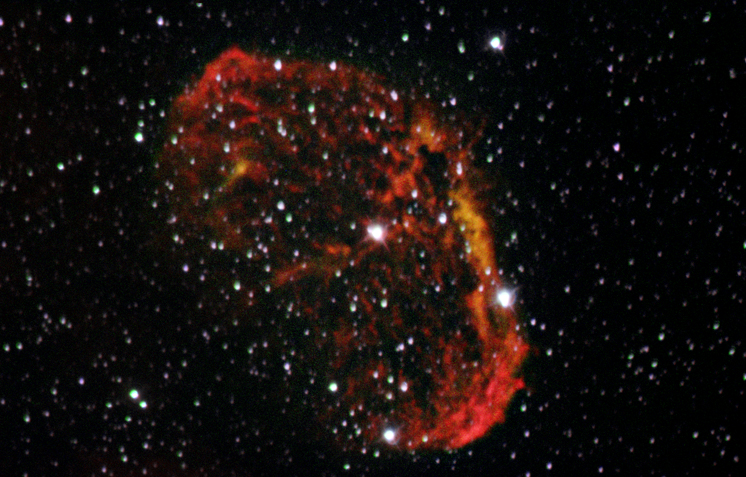 |
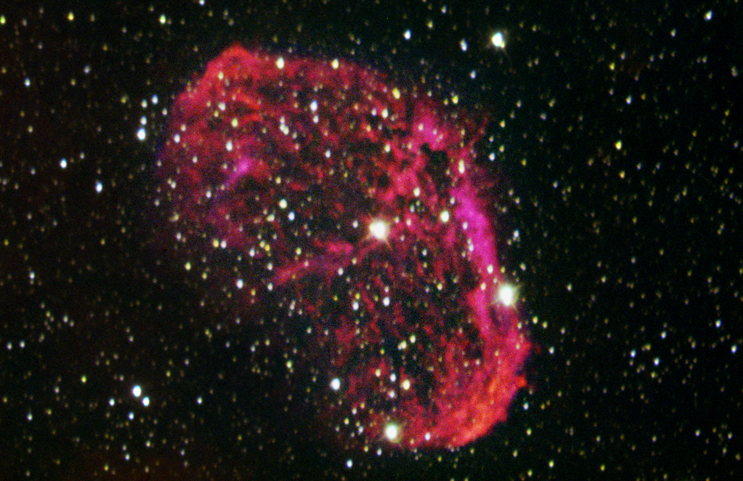 |
NGC 6888 Emission Nebula “The Crescent” in Cygnus. AT8RCF @ f/8, 6000 secs. H-a, S-II & O-III. Taken Oct. 25-27, 2013 from under the Columbus nebula. Combined using the Hubble Space Telescope palette. Posted 29 Oct. 2013 |
The Crescent with the color layers recombined using the CFHT palette. Posted 29 Oct. 2013 |
The Crescent with the color layers recombined using the Kitt Peak palette. Posted 29 Oct. 2013 |
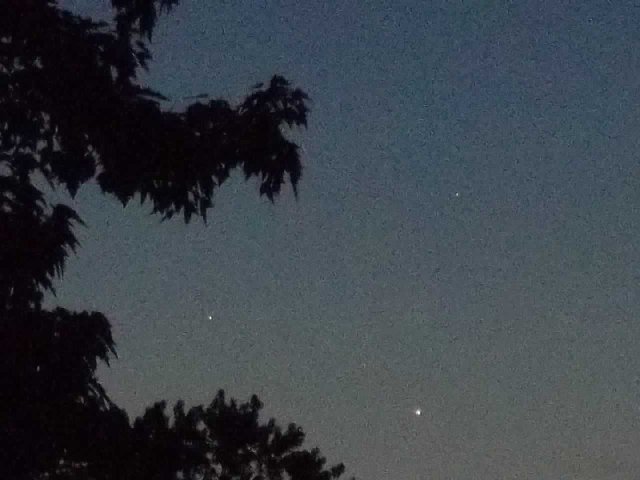 |
||
| Triple Conjunction of Mercury, Venus and Jupiter taken on May 26, 2013 with my Kodak Easyshare point and shoot. |
More images coming soon!
Clear, Dark and Steady Skies!
Back to Top of Page
Back to Ted's Astropix Directory